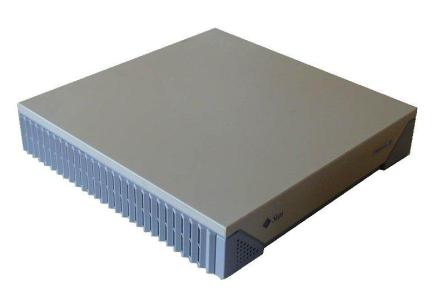
CPU: microSPARC II @ 70/85/110MHz, TurboSPARC @ 170MHz
Max Ram: 256MB
chassis: Pizza box
bus: SBus: 3 slots, AFX: 1 slot
Menu:

The SPARCstation 5 is a pizzabox SPARC machine available in four flavours; a microSPARC II at 70MHz, 85MHz
110MHz or a Fujitsu TurboSparc @ 170MHz. The 170MHz version has compatibility issues with many distributions
of Linux due to the different CPU type.

My SS5 is currently in a not working state. One day without warning it just wouldnt start up properly. After building a suitable null-modem cable out of a modem cable, 9-to-25 adapter, a DB9 null-modem cable and 25pin SCSI-1 cable I managed to see what the problem was. ecache failure part way through POST. So it seems the machine is beyond repair. Put the RAM and fixed-disk in the SS4 but sadly the CD-ROM drive was too big. The SS4 remains CD-ROM drive-less.
SPARCstation 5
Processor(s): microSPARC II @ 70MHz or 85MHz, 57.0/64.0
SPECint92, 47.3/54.6 SPECfp92, 1352/1518
SPECintRate92, 1122/1295 SPECfpRate92
Bus: SBus
Memory: 256M physical
Architecture: sun4m
Notes: 16M standard in 70MHz model, 32M standard in
85MHz model. 8 SIMM slots, 8M or 32M SIMMs,
mixable except that any 32M SIMMs must be in
slots before any 8M SIMMs. Code name "Aurora".
Uses SCA connectors (see Misc Q&A #29) for
internal SCSI drives. Socketed CPU chip.
Unlike the SPARCstation 4 this machine does not have an onboard graphics chipset. An SBus framebuffer would normally be used. The SPARCstation 5 also includes a higher speed bus known as AFX which shares its connection with SBus slot 3. The bus seems to have been created exclusively for higher-speed graphics cards. The AFX bus seems to have only existed for the SPARCstation 5 series - it has not been found in any other SPARCstation or server of any model.
The SPARCstation 5 is capable of taking two SCA SCSI hard disks mounted in the front-left corner of the case.
The SCA connector provides SCSI, Power and sets the SCSI ID. The bottom of the two connectors sets the ID to
#3 which is the default boot ID. The top SCA connector sets the ID to #1.
The right side of the case can take a CD-ROM drive and a floppy drive. Earlier versions of the case required
a special 1-inch-high CD-ROM drive built by Toshiba. Later versions of the case slimmed the floppy drive in
the lower bay to allow a normal height CD-ROM drive.
Some systems come with a socketed CPU which allows for upgrades. When upgrading the CPU the RAM timing jumpers
must be adjusted. Socketed machines can go from 70MHz to 160MHz (using the Fujitsu TurboSparc upgrade).
 To give the image here of the jumpers a frame of reference, the machine is set to 100Mhz
(for the microSparcII at 110Mhz). Jumper "J0103" is on (1) while J0104 is off (0).
To give the image here of the jumpers a frame of reference, the machine is set to 100Mhz
(for the microSparcII at 110Mhz). Jumper "J0103" is on (1) while J0104 is off (0).
J0105 and J0106 are on the other side of the CPU, near the floppy, SCSI and power
connections. These jumpers set the "divide control" bits used by the microSparc II.
Set a 70Mhz machine to divide by 3 to obtain an SBUS speed of 23.33Mhz. Set an 85Mhz
machine to divide by 4 to obtain an SBUS speed of 21.25Mhz. Set a 110Mhz machine to divide
by 5 to obtain an SBUS speed of 22Mhz.
|
| ||||||||||||||||||||||||||||||||||||
| Table of Sun Sparc 5 Model Configurations | ||
|---|---|---|
| Model Type | Sun Part Number | Notes |
| Sparc 5 70Mhz | 501-2286 501-2472 501-2508 501-2798 501-2802 501-2811 | Originally shipped with 0MB RAM, earlier revision CPU Originally shipped with 16MB RAM, earlier revision CPU Originally shipped with 32MB RAM, earlier revision CPU Originally shipped with 0MB RAM, later revision CPU Originally shipped with 16MB RAM, later revision CPU Originally shipped with 32MB RAM, later revision CPU |
| Sparc 5 85Mhz | 501-2572 501-2574 501-2799 501-2803 501-2815 501-2816 | Originally shipped with 0MB RAM, 2.3/2.5 revision CPU Originally shipped with 32MB RAM, 2.3/2.5 revision CPU Originally shipped with 0MB RAM, 3.x revision CPU Originally shipped with 32MB RAM, 3.x revision CPU Originally shipped with 0MB RAM, 2.6 revision CPU Originally shipped with 32MB RAM, 2.6 revision CPU |
| Sparc 5 110Mhz | 501-2778 501-2779 | Originally shipped with 0MB RAM Originally shipped with 32MB RAM |
| Sparc 5 170Mhz | 501-3059 501-3103 | Originally shipped with 0MB RAM Originally shipped with 32MB RAM |